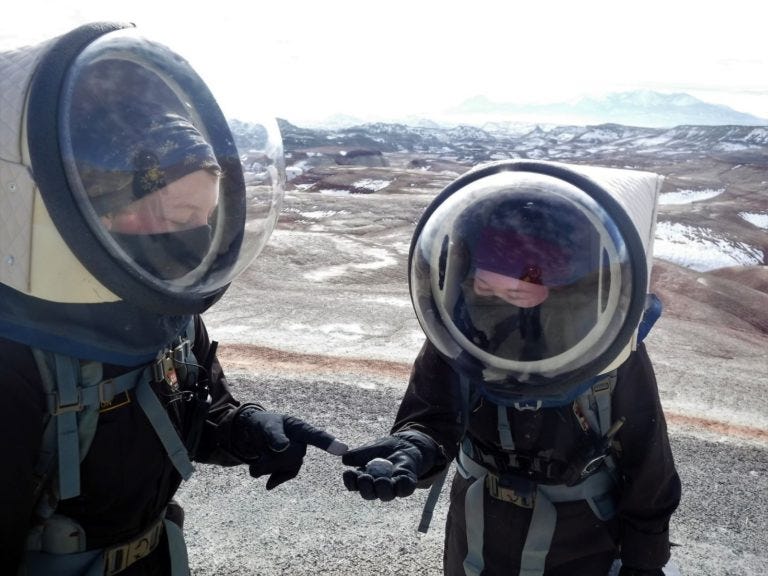Purdue Students Move To ‘Mars’ For Two Weeks
 Crew Engineer Kasey Hilton points to a rock she collected for crew geologist Ellen Czaplinski.
Crew Engineer Kasey Hilton points to a rock she collected for crew geologist Ellen Czaplinski.
Subscriber Benefit
As a subscriber you can listen to articles at work, in the car, or while you work out. Subscribe NowA team of six Purdue University students and alumni is readjusting to life on planet Earth after spending two weeks on “Mars.” Although they didn’t travel to the real Red Planet, the crewmembers lived in isolation inside a small research station in a remote area of Utah, where the rugged, red-hued landscape resembles Mars’ geology. The crew lived inside a small, two-story cylinder-shaped building—just 26 feet in diameter—to simulate life on the distant planet and push science one step closer to a human mission to Mars.
“It kind of felt like you were actually on Mars; it was very bizarre,” says Kasey Hilton, a Purdue chemistry student who was part of the Purdue MartianMakers team.
The Mars Society operates the Mars Desert Research Station (MDRS) in Utah and selected the Purdue crew through the university’s Mars Activities and Research Society. Various teams periodically take control of the simulation facility in Utah to clear the scientific, operational and human hurdles to space travel. The Boilermakers became “MartianMakers” December 30 through January 12.
Life at the MDRS mirrors what an astronaut would experience while stationed on Mars, which NASA says is possible by the 2030s. For example, the habitat—or crew’s living area—must operate on a limited power and water supply; Purdue agricultural and biological engineering graduate Jake Qiu says he took one “Navy shower” and, otherwise, relied on baby wipe “baths.”
Freeze-dried goods that are rehydrated with water comprise most of the Mars diet. A small greenhouse grows some produce; the Purdue team celebrated New Year’s Eve by eating fresh salad. Crewmembers can only leave the “habitat” wearing spacesuits to complete fieldwork in the surrounding desert.
Other aspects of life at the MDRS test the more psychological elements of life on the Red Planet; a mission to Mars would require eight months just to reach the planet, plus the duration astronauts would stay, followed by the eight-month trip back to Earth. The Purdue team, like all crews at the MDRS, were nearly cut off from communication with the “outside world”—no phones or Internet. Living in close, confined quarters tests the social and emotional aspects of space travel.
Crewmembers also conduct their own research during the two-week stay. Qiu, who plans to study the gut microbiome in graduate school, examined how the microorganisms responded to the unusual environment.
“I don’t think people consider the biological consequences of space travel,” says Qiu. “Our gut microbiome can help regulate our health, but in space, some microbes behave differently—[due to] microgravity or radiation levels. There are known incidents in which some microbes that are typically not pathogenic become pathogenic.”
Qiu explains that humans sometimes have pathogenic microbes in their guts, but they’re suppressed by their healthy counterparts.
“If pathogenic strains come along onto the spaceship and Mars colonization, and we’re growing plants on Mars, what would happen if those microbes get impacted to the greens? [If the pathogenic strains grow in abundance], now we’re eating those greens; maybe then they can cause diseases?”
Qiu grew microgreens in the Martian greenhouse to work toward finding the answer. Hilton’s research also related to growing food on Mars. Compost could be more critical on Mars; produce can’t be grown in the planet’s native soil, because it’s toxic. Hilton tested if only the waste created at the MDRS could generate a robust compost.
“You need the correct ratio of carbon-rich waste to nitrogen-rich waste to have a healthy compost,” says Hilton. “From what we produced on Mars, you would be able to make a really good compost out of it. It was, essentially, the exact opposite of what I thought would happen.”
While Purdue is referred to as “the cradle of astronauts,” Hilton and Qiu doubt the real-life Mars is in their future flight plans, but both hope to be among scientific support teams that send astronauts on such a groundbreaking mission.
“The chief engineer for the Mars 2020 rover mission came to Purdue recently and said, ‘Thank God I didn’t know where my curiosity would take me,’” says Hilton. “That describes [our experience] perfectly—thinking about how much you can do if you just follow your curiosity.”
As Crew Engineer, Hilton was responsible for fixing anything that broke, which she says was challenging on “Mars.”
Hilton says the EVAs (Extra Vehicular Activities) were her favorite part of the mission; EVAs involve putting on space gear and completing fieldwork outside the habitat.
Qiu says he studied how the crewmembers’ microbiomes impacted the microbiomes of microgreens he was growing in the ‘Martian’ greenhouse.
